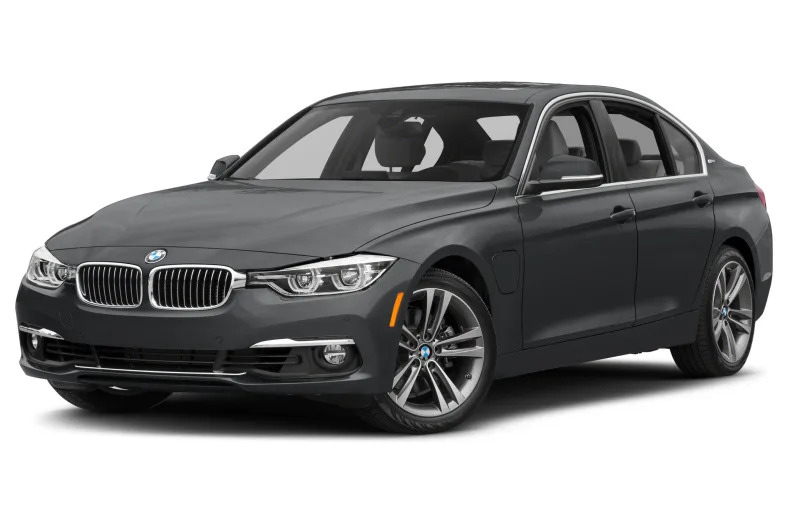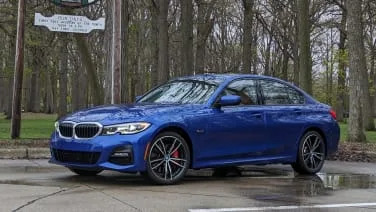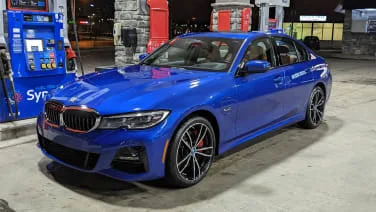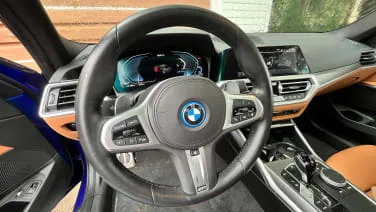Base 4dr Rear-Wheel Drive Sedan
2016 BMW 330e
Piecing together the i8 eco sports car taught BMW some valuable lessons, some of which you'll see in the next generation or two of the company's electrified mainstream cars. You won't have to wait that long for BMW to deliver on the key lesson, which can be seen right here in the 330e: make hybrids fun to drive and don't make people compromise on what they like. The 330e neatly sidesteps the traditional character-blanching entry ticket you get with hybrids by delivering almost as much torque as the 340i and a sprint time to 62 miles per hour of 6.1 seconds. For most people eco-conscious enough (especially in a time of cheap gas) to bother with plug-in hybrids, that's going to be quick enough. And so is the 140-mph top speed. It won't quite manage the precision of a normal 3 Series because it's 353 pounds heavier, but it's not far away. This 330e is (theoretically) capable of delivering 25 miles of electric-car range or ridiculous amount of range as a gasoline-electric hybrid. It will post a 44-gram CO2 emissions figure and officially deliver 1.9 liters/100km on the NEDC test cycle in Europe, which translates to 124 miles per gallon equivalent in the US, though it's unclear what the EPA-certified number would actually be. While punching in a straight line is always good, and sipping fuel like it's being rationed is nice, the key part to the 330e is that still handles like a 3 Series should every time you arrive at that one fun corner. It won't quite manage the precision of a normal 3 Series because it's 353 pounds heavier, but it's not far off. BMW has buried the 7.6-kWh lithium-ion battery pack beneath the cargo floor, while the electric motor resides up front, so the weight distribution moves from 50:50 to 49:51, leaving it a touch heavier in the back. Effectively, it's a 3 Series with the 320i's 2.0-liter, four-cylinder gasoline powertrain, the standard eight-speed automatic transmission, and an electric motor sandwiched in between to create a hybrid. The electric motor adds 87 hp to the gas engine's 181 horsepower to offer 248 hp of total power (yes, we know they don't directly add up, but that's the total output). While it has 74 pound-feet of continuous torque, the electric motor can overboost to 184 lb-ft when it needs to. Add that to the gas engine's 214 lb-ft and the car has a maximum of 310 lb-ft – 22 lb-ft shy of the 340i, without pumping out as many emissions. The beauty is that it's capable of running as an electric car while asking you to make very few compromises anywhere else. The 330e's brain is geared, in its default-driving mode, to drain everything possible from the battery by the time you get to where you're going, because that's the most efficient way to drive. The 330e does all of this by judging the navigation route, including real-time traffic information, and giving the ECU a which-engine-to-use-now template …
Full Review
Piecing together the i8 eco sports car taught BMW some valuable lessons, some of which you'll see in the next generation or two of the company's electrified mainstream cars. You won't have to wait that long for BMW to deliver on the key lesson, which can be seen right here in the 330e: make hybrids fun to drive and don't make people compromise on what they like. The 330e neatly sidesteps the traditional character-blanching entry ticket you get with hybrids by delivering almost as much torque as the 340i and a sprint time to 62 miles per hour of 6.1 seconds. For most people eco-conscious enough (especially in a time of cheap gas) to bother with plug-in hybrids, that's going to be quick enough. And so is the 140-mph top speed. It won't quite manage the precision of a normal 3 Series because it's 353 pounds heavier, but it's not far away. This 330e is (theoretically) capable of delivering 25 miles of electric-car range or ridiculous amount of range as a gasoline-electric hybrid. It will post a 44-gram CO2 emissions figure and officially deliver 1.9 liters/100km on the NEDC test cycle in Europe, which translates to 124 miles per gallon equivalent in the US, though it's unclear what the EPA-certified number would actually be. While punching in a straight line is always good, and sipping fuel like it's being rationed is nice, the key part to the 330e is that still handles like a 3 Series should every time you arrive at that one fun corner. It won't quite manage the precision of a normal 3 Series because it's 353 pounds heavier, but it's not far off. BMW has buried the 7.6-kWh lithium-ion battery pack beneath the cargo floor, while the electric motor resides up front, so the weight distribution moves from 50:50 to 49:51, leaving it a touch heavier in the back. Effectively, it's a 3 Series with the 320i's 2.0-liter, four-cylinder gasoline powertrain, the standard eight-speed automatic transmission, and an electric motor sandwiched in between to create a hybrid. The electric motor adds 87 hp to the gas engine's 181 horsepower to offer 248 hp of total power (yes, we know they don't directly add up, but that's the total output). While it has 74 pound-feet of continuous torque, the electric motor can overboost to 184 lb-ft when it needs to. Add that to the gas engine's 214 lb-ft and the car has a maximum of 310 lb-ft – 22 lb-ft shy of the 340i, without pumping out as many emissions. The beauty is that it's capable of running as an electric car while asking you to make very few compromises anywhere else. The 330e's brain is geared, in its default-driving mode, to drain everything possible from the battery by the time you get to where you're going, because that's the most efficient way to drive. The 330e does all of this by judging the navigation route, including real-time traffic information, and giving the ECU a which-engine-to-use-now template …
Hide Full Review
Hide Full Review
Retail Price
$43,700
MSRP / Window Sticker Price
| Engine | I-4 |
| MPG | 28 City / 36 Hwy |
| Seating | 5 Passengers |
| Transmission | 8-spd w/OD |
| Power | 184 @ 5000 rpm |
| Drivetrain | rear-wheel |
Smart Buy Program is powered by 





